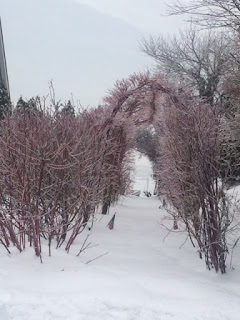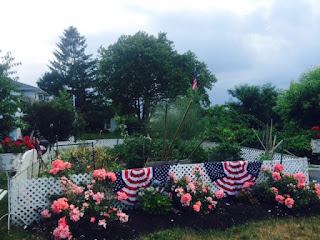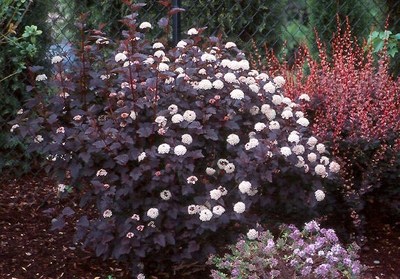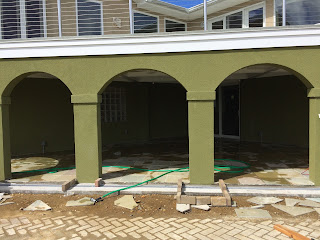 |
| Garden State Water Garden & Arbor |
I hosted a garden tour at our Garden State country house on a Saturday in early June.
Well, besides me, my co-hosts were my husband, Bill -- and Mother serving as our official greeter, as it turned out. But I was the one who got us hooked into this, ahem, occasion.
While our home was/is undergoing the second phase of mmmm - let’s see, maybe three or four (or more) design renovations - and a few yet to come – I thought I must be crazy to agree to this.
Ha. With regard to the passages of home renovation, we’re fond of saying, “All it takes is time, money, and patience.”
My thinking on whether to participate in the Garden Tour lined up in two camps: The "holy cow," our house is under duress due to the interior renovation. That was quickly followed by the reality that our exterior-designed garden rooms are evolving. So while I’m justifiably proud of the garden designs and bask in the harvest of our homegrown “farm-ette” -- I wasn’t sure we were exactly ready for prime time viewing, if you know what I mean.
Yet – Eileen from the Atlantic Highlands Historical Society (AHHS) came for the garden inspection/review and seemed quite enthusiastic and affirmative – so long story short, I was shaking hands, smiling with Eileen, declaring, “We’re in.”
As a garden designer, community supporter, garden historian, and garden specialist, it was a privilege and an honor to share our varied garden rooms as part of the Annual House & Garden Tour. In surely what must be a funny twist of local “logic” - the Annual House & Garden Tour had, in fact, been on hiatus since 2012 - and neither did it feature a garden on the tour for, well -- awhile. I joked that in the end, wouldn’t that make it really just a house tour?!
While the Saturday of the scheduled House & Garden tour broke cloudy and threatened rain, I donned a happy-Spring, lime green, flower-bedecked dress and my knee-high pink boots.
I noted the possibility of rain in the weather forecast, right?!
 |
| I never looked better! Pink boots & all |
We were ready with our welcome table set up in the driveway near the street to greet the hoped-for guests. It was gloomy, so I thought, we won’t get a lot of visitors to the first-in-the-series garden part of the tour, figuring most everyone would prefer to tour inside the other five or six houses - as part of the home decor / main element of the House Tour.
While I lamented the dim weather and its impact on the tour, I was somewhat sanguine as I could then use the time to work on some garden design client work that was fast approaching its deadline.
Our assigned Historical Society guide was prompt; ready to greet and manage the visitors. Did I mention that I was told the (wonderful) volunteer guides were provided to allow the homeowner to go about their day and not need to be engaged in the tour? Well, that was the very thoughtful strategy.
Undoubtedly the weather was increasingly clouding expectations so when it started to “spritz,” I asked the volunteer guide to come inside and join me in the kitchen where I was working at the Mac on the kitchen island.
But then, like the weather vane in a dramatic movie, things changed rather abruptly.
The sprinkling rain mist stopped. People started coming. And coming. And coming. First in small group pockets. Then in waves. Then, once the sun started peeling off the cloud wraps, the visitation was more of a tsunami. In a good way. No climate change disasters here - other than having those pink rubber rain boots turned into “feet sauna” later on when the thermostat started to soar upwards and no time to change footwear fashion!
While Mother was at the greeting table, street-side with the AHHS guides - and we welcomed new guides as the afternoon came on - something dawned on me early in the day when the first visitors started arriving.
 |
| Mother/Greeter. And Bloody Marys! |
See, unlike an interior house tour where even if one knows “zero/nada” about home decor or design - they can still pretty much grasp the look. They like it. Or parts of it. Or the feel of it…
Not so with gardens and horticulture.
OK - while there is no doubt those heart-stopping moments when one views a beautiful, abundant, flower-rich garden or containers or window boxes, (this being June there was not so much “aggressive abundance”) when the viewer just needs to take in the landscape. But there exists the-not-to-be-ignored fact that, increasingly (sad to say), most folks don’t know anything about gardens or garden design unless it’s annual-based plant or found at a big box store’s “garden” department. Let’s not get started on native or local plants or edibles… (There is even a recognized phenomenon called Plant Blindness. Most folks just see “green.” I love that. But I wanted our Garden Guests to understand the story and thoughtful garden design that went into the “garden room” compositions. And to get to know the Art of the Plants. The amazing, wonderful, colorful, seasonal, intriguing, compelling, and seductive world of plants…
While I took the opportunity to produce a Garden Tour Plant List Guide (see below) and Mother and I labeled the major plants or plant groups with popsicle-sticks with the plant names written on them, I just had the feeling that I needed to provide a one-on-one, hands-on garden tour.
Bill too, “stepped up,” providing the same personalized tour guidance for the farm-ette and the orchard.
We do love our gardens. They provide beauty and food. And they are endlessly beguiling...
I often say to my garden clients - and at my garden talks - that every good garden tells a story.
Our garden design narrative is understandably personal - yet it possesses and embodies a broad, enduring, garden story… Change is constant.
At the end of the day, we hosted probably more than 70 garden guest visitors!
I started the tour taking them from the street side and still-emerging border garden,
on to the Arbor - a gateway to the back or water-side gardens.
The design hallmark of the arbor is the color red. In the summer the red Knockout roses bloom vociferously, bordered by Lady in Red hydrangeas.
The mainstay of the arbor is the tree Coral Bark - Acer palmatum ‘Sango-kaku’ with its happy bright green leaves in summer (and yellow in autumn) growing over the arbor frame - that Bill made for me.
In winter, its brilliant and distinctive showy red bark distinguishes the arbor. It’s truly a tree for all seasons. Fronted by the Red Twig Dogwood shrub Cornus sericea ‘Cardinal’ or red osier dogwood - the winter garden look is stunning with a bright red against the white of winter snow.
 |
| The winter arbor - with a little sugar dusting! |
 |
| Winter Arbor side view. Good bones make for a great garden in every season |
The garden tour continued…
After viewing the Terrace herb garden and the newly discovered garden pocket and new plantings for the St. Francis rock garden (must be the karma in honor of our great new pope!), we’d stop for a glass of my homegrown Agastache | Hummingbird Mint, homemade, iced tea flavored with local honey. It never failed to elicit a “Wow” reaction. A something new and delicious taste treat - fresh from the garden. Want the recipe? Write me - I’ll be happy to share.
Then it was on to the Outdoor Shower,
the Potting-Up and Secret (hosta) Garden,
the Farm-ette - Garden Guests could not get over the asparagus or the peas - and their just-picked taste!
 |
| Asparagus in right back side - billowy grass-like, peas border fence |
and Orchard, and back up through the Terrace and Herb Garden out to the Water Garden & Fountain with its Lavender and Boxwood Parterres, urn, fish and evergreen Cherry Laurel (Prunus laurocerasus) shrubs and Liriope spicata.
 |
Bill, in the Old Navy shirt (& that's not just a brand - he IS Old Navy! ha - Bill explaining edible Farm-ette garden
|
 |
| The Water Garden bones make it so pretty in the snow, too |
Then on to the front “foundation” bed of native New Jersey Blueberries -- also great red color in autumn Selecting Blueberry Varieties for the Home Garden and Star Magnolia (Magnolia stellata) that I positioned right under the kitchen window. Its showy white flowers are the first to bloom in spring - even before the leaves come out -- and the blooms are wonderfully fragrant wafting their scent up to the house through that window. (Working at the sink is never so good.) In the winter, the magnolia’s pussy willow-like jackets shimmer in the sun.
Behind the magnolia are evergreen (drought-tolerant) shrubs: white, Winter Blooming Camellias (Camellia sasanquas).
And then there is the heart-clutching show-stopper - as seen from any perspective - the glorious, regal, Kwanzan cherry tree. A stunning beauty that literally takes your breath away.
Following is the excerpt that the Historical Society included in their event day brochure, highlighting the gardens - and a profile of me. Wow. Blushing…
We are excited to announce that Leeann and her husband Bill share their garden rooms and views with us for the first time on our 2015 House Tour!
You are in for a treat to be greeted by a Kwanzan Cherry, and while traveling through the garden rooms, will experience the beauty of the Garden State blueberries, White Star Magnolia, Camellias, Cherry Laurel, Boxwood Parterres, Lavender, Salvia, Coral Bark Trees, Red Twigged Dogwoods, Knockout Roses, Lady In Red Hydrangeas, Montauk Daisy as well as the farm garden and fruit trees which end a beautiful and bountiful journey.
LEEANN LAVIN
The well-known garden designer, historian, coach, writer and speaker, Leeann Lavin, calls Atlantic Highlands home for many reasons... Her commute to and from the New York Botanical and Brooklyn Botanic Gardens where she is/was a staff member, is a faster, easier and beautiful way to commute by ferry. Her love of our community, and what she can contribute with her experience having traveled gardens throughout Japan, China, Europe, the Caribbean, Central America and the United States, are both rewarding lifestyle goals, which she has not only achieved, but continues to measure and grow in. Her gardens are all a labor of love and a progressive natural production with spectacular and entertaining results.
What greets you at curbside, is a show-stopping Kwanzan Cherry. It is a brilliant spectacle of living art with its pink-petaled, double blossoms that eventually fall link pink snow. The walkway design was inspired in equal parts as reverence for the tree and to allow guests to transition to the “garden room” or the house. Made of slate and brick, the path offers a choice to either turn left or continue on to the front door, or to take a garden walk, where the water garden beckons. To the left are native Garden State blueberries, a White Star Magnolia, the first to bloom in spring with white, fragrant blooms, and in the autumn, there are winter blooming white camellias.
To the right is the Water Garden, bordered by Cherry Laurel evergreen shrubs. Boxwood parterres are filled with fragrant lavender and salvia, and in the center, a beautiful urn and fountain.
Bordering the property is a secluded stretch of a red-themed arbor, which canopies and drapes every visitor with Coral Bark trees, Red Twigged Dogwoods, with red Knockout Roses and Lady in Red Hydrangeas gracing the sides of the arbor. The peaceful journey through the arbor to expansive water views from The Raritan Bay to the west, and sweeping to the east, lower Manhattan, Staten Island, Queens, The South Shore of Long Island, Sandy Hook Bay, and The Atlantic Ocean.
The herb garden has already been well-established and has “visitors” or “plant guests” from their succulent relatives throughout. Bordering the terrace garden, are Knockout Roses and Montauk Daisy.
The farm-ette garden has well established asparagus, garlic, potatoes, peppers, shallots and peas. New, tender lettuces, spinach, arugula, tomatoes and peppers are making their appearances with the thrill of a bountiful harvest throughout July, August, September and beyond.
Just beyond the farm-ette is a mini-orchard with dwarf cherry, peach and apricot trees. Along with the male apple tree that fertilizes the espalier female apple tree that adorns the front porch wall. The fruit trees complete the culinary palette of the gardens.
Some of Leeann's designs are featured in the book, Cottages & Mansions of the Jersey Shore. Leeann is also the author of her own book: The Hamptons & Long Island Homegrown Cookbook, which tells the stories of locavore chefs, and the artisanal growers and makers -- along with the land and sea -- that inspires them most. Both books will be on display and available for sale and signature.
Here is the plant list and guide I printed out and gave to our garden guests.
Plant List for Leeann & Bill’s Garden State Ornamental & Edible Garden Rooms
Side Border
 Ninebark, Diablo. Physocarpus opulifolius Flowering plant in the Rosaceae family, native to North America, drought tolerant.
Ninebark, Diablo. Physocarpus opulifolius Flowering plant in the Rosaceae family, native to North America, drought tolerant.
Bed includes Spring & Fall blooming Grape Hyacinths
Knock Out Roses - in apricot color
Purple Annuals at their feet, including Columbine
Kanzan Cherry Tree - Named after a mountain in Japan, Prunus ‘Serrulata’ ‘Kanzan’ is breathtaking in late spring with stunning, double pink blossoms, that fall like pink snow. Luminous dark bark, pretty, orange fall leaves.
Viburnum
Welcome Garden Bed
 White Star Magnolia, Magnolia stellata. Slow-growing shrub or small tree, it is the first to bloom in spring - before leaves open - it bears showy, fragrant blossoms - hence it was placed under kitchen window to enjoy the sensual show…
White Star Magnolia, Magnolia stellata. Slow-growing shrub or small tree, it is the first to bloom in spring - before leaves open - it bears showy, fragrant blossoms - hence it was placed under kitchen window to enjoy the sensual show…
Native New Jersey Highbush Blueberries Vaccinium corymbosum help make the Garden State the second largest producer of blueberries nationwide.
Centuries before the arrival of the colonists, Native Americans gathered blueberries from the forests and the bogs. They were consumed fresh and also preserved. The Northeast Native American tribes revered blueberries and folklore developed around them. The blossom end of each berry, the calyx, forms the shape of a perfect five-pointed star; the elders of the tribe would tell of how the Great Spirit sent "star berries" to relieve the children's hunger during famines.
Blueberries were also used for medicinal purposes along with the leaves and roots. A tea made from the leaves of the plant was thought to be good for the blood. Blueberry juice was used to treat coughs. The juice also made an excellent dye for baskets and cloth. In food preparation, dried blueberries were added to stews, soups and meats. The dried berries were also crushed into a powder and rubbed into meat for flavor. A beef jerky called Sautauthig (pronounced saw'-taw-teeg), was made with dried blueberries and meat and was consumed year round.
An important step in the development of the highbush blueberry industry came in the turn of the century. Efforts in the early 1900's by Elizabeth White and Dr. Frederick Coville to domesticate the wild highbush blueberry resulted in today's cultivated highbush blueberry industry.
Camellia - Fall Blooming - evergreen Camellia Snow Flurry (oleifera x 'Frost Princess')
Espaliered Apple Tree
Welcome Border
Agastache, Fountain Grass ‘Red Head’ - Pennisetum alopecuroides, Amsonia hubrechti, Hibiscus ‘Lord Baltimore’ Rose Mallow, Eupatorium ‘Little Joe’, Liatris spicata, Hakonechloa ‘Aureola’ - 2009 Perennial Plant of the Year
Arbor
Red Twig Dogwood - Cornus sericea, Native to North America, brilliant red stems in winter
Coral Bark Japanese Maple - Sango-Kaku Acer palmatum, branches are brilliant red in winter
Lady in Red Hydrangea - Hydrangea macrophylla “Lady in Red”
Knock Out Red Rose
Crape Myrtle - Lagerstroemi (indica x fauriei ‘Tonto’) - semi-dwarf variety, this cultivar has brilliant rich red floral display July through September
Herb Garden
Catmint - Nepeta ‘Walkers Low’ - It is said that the nepetalactone contained in some Nepeta species binds to the olfactory receptors of cats, typically resulting in temporary euphoria.
Yarrow - Achillea millefolium - In antiquity, yarrow was known as herbal militaris, for its use in staunching the flow of blood from wounds. Common names include “nosebleed plant, devil’s nettle, soldier’s woundwort”
Sedum - Herbstfreude tephinum ‘Autumn Joy’ - late summer, early fall rosy pink color
Lambs Ears - Staychys byzantina
New York Aster - Aster novi-belgii - So named for when New York was known as New Belgium - lilac blue flowers in autumn 
Herbs: Rosemary, Aji Amarillo Peppers, Fennel, Lettuce, Sage, Lovage, Grape Vine
Terrace Garden: Annuals, including New Guinea Impatiens, Dracena, Potato Vine, Ferns, Succulents; Star Gazer Lilly, Phlox, Climbing Hydrangea - Hydrangea anomala ssp.petiolaris, White Knockout Rose, Hydrangea - Hydrangea macrophylla, Fall blooming Montauk Daisy - Nipponanthemum nipponicum
Shower Garden
Yucca, Clematis x jackmanii - a genus of the buttercup family, Miscanthus ‘Little Kitten’
Secret Garden
Hosta
St. Francis Rock Garden
Delphinium - ‘Summer Stars,’ Little Bluestem - Schizachyrium, Evening Primrose - Oenothera Missouriensis, Linaria, Sedum ‘Blue Spruce,’ Sedum ‘Red Ice’
Edible “Farm-ette”
Asparagus, peppers, peas, potatoes, garlic, onion, shallot, tomatoes, arugula, eggplant, Japanese spinach
Orchard
Dwarf: Garden Annie Apricot Tree, Bonfire Peach Tree, Golden Delicious Apple Tree, North Star Cherry Tree
Water Garden
Cherry Laurel - Prunus laurocerasus - fragrant cherry in spring, evergreen, vigorous shrub - great for screening. Borders the water garden and parterres. Provides screening, yet air of mystery to allow for seeing - a “What’s inside there…” sense of discovery
Lavender - Lavandula, Salvia - The largest genus of plants in the mint family, commonly referred to as sage; Boxwood, Buxus.
Aquatic/Water Plants: Papyrus, Cyperus papyrus - the sedge family, Horsetail, Equisetum- a “living fossil” - dates from the Paleozoic period. Water Hyacinth - Eichhornia crassipes, Water Lily, Nymphaeaceae































